Artistic and Aesthetic Representation of the Mythological Image of the Water Damosel in the Bashkir Folk Epic (on the Material of the Epics “Akbuzatˮ and “Zayatulyak and Khyuhyluˮ)
Abstract
Using the Bashkir epics “Akbuzatˮ and “Zayatulyk and Khyukhyluˮ, the article examines the mythical image of the water damosel – khaukhylu, which has significant artistic and aesthetic functions. This image takes a special place in the mythology of all peoples and in ancient sacred beliefs. Due to the fact that after the adoption of Christianity / Islam among the peoples, all the once sacred, pagan deities – the keepers of rivers and lakes, mountains and natural boundaries, forests and fields, as well as the ones connected with home, were endowed with a negative characteristic and began to be represented as an evil spirit. Such a fate was waiting for, for example, the traditional hero Baba Yaga – Yashchura, raised to the rank of a positive character, deified by the canon of the ancient Slavs, she was the keeper of the clan, its traditions and customs. Accordingly, after the adoption of Christianity, Yashchura took on that negative, pernicious character known to us from Slavic folk tales and folkloric accounts. As E.V. Pomerantsev correctly states, in the artistic and aesthetic sense in mythological legends and folkloric accounts there are always similar motives of “sudden meetingˮ, “sinking into the underwater kingdomˮ, “awards of the water kingˮ, “... the marriage of a hero in the underwater kingdomˮ, etc. In the Bashkir epic monuments observed in the article, these motives are strictly traced and successfully actualized.
Downloads
Metrics
References
Атдаев С. Дж. Русалки и водяные девы – сув-периси в традиционном представлении туркмен // Народы и религии Евразии. 2019. №1 (18).
Жирнова Г.К. Образ русалки в мифах, легендах и произведениях русских писателей [Электронный ресурс]. URL: http://festival.1september.ru/articles/557136.
Левкиевская Е.Е. Мифы и легенды восточных славян. М., 2010. [Электронный ресурс]. URL: https://kartaslov.ru
Померанцева Э.В. Мифологические персонажи в русском фольклоре. М., 1975.
Хуббитдинова Н.А. Художественное отражение фольклора в литературе XIX в. (к проблеме русско-башкирских фольклорно-литературных взаимосвязей). Уфа, 2011.
Чжоу Яньянь Образ «美人鱼 / русалка» в русской и китайской традиции: общее и особенное // Научный диалог. 2017. № 5. [Электронный ресурс]. URL: https://cyberleninka.ru/article/n/obraz-rusalka-v-russkoy-i-kitayskoy-traditsii-obschee-i-osobennoe/viewer
Элиде К.П. Аспекты мифа. М., 2001.
Список источников
Башкирский народный эпос: Эпос народов СССР. М., 1977.
Башкирское народное творчество. Обрядовый фольклор / сост., авт. вступ. ст. и коммент. Р.А. Султангареева и А.М. Сулейманов. Уфа, 2010.
Даль В.И. Башкирская русалка // Башкирия в русской литературе. В 6 томах. Т. 1. Уфа, 1989.
Женщина в мифах и легендах: энциклопедический словарь. Ташкент, 1992.
Мифы древних славян. Саратов, 1993.
Редакционная коллегия научного журнала «Филология и человек» придерживается принятых международным сообществом принципов публикационной этики, отраженных, в частности, в рекомендациях Комитета по этике научных публикаций (Committee on Publication Ethics (COPE), Кодекс этики научных публикаций), а также учитываeт ценный опыт авторитетных международных журналов и издательств.
Во избежание недобросовестной практики в публикационной деятельности (плагиат, изложение недостоверных сведений и др.), в целях обеспечения высокого качества научных публикаций, признания общественностью полученных автором научных результатов каждый член редакционной коллегии, автор, рецензент, издатель, а также учреждения, участвующие в издательском процессе, обязаны соблюдать этические стандарты, нормы и правила и принимать все разумные меры для предотвращения их нарушений. Соблюдение правил этики научных публикаций всеми участниками этого процесса способствует обеспечению прав авторов на интеллектуальную собственность, повышению качества издания и исключению возможности неправомерного использования авторских материалов в интересах отдельных лиц.





